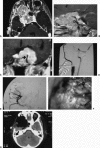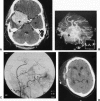Extracranial-to-intracranial bypass using radial artery grafting for complex skull base tumors: technical note
- PMID: 16175230
- PMCID: PMC1214706
- DOI: 10.1055/s-2005-872596
Extracranial-to-intracranial bypass using radial artery grafting for complex skull base tumors: technical note
Abstract
The management of complex skull base tumors that incorporate large intracranial vessels poses challenging questions. Patients who fail initial surgical resection and adjunctive therapies (i.e., radiosurgery) who present with tumor regrowth may be candidates for parent vessel occlusion and total tumor resection in combination with extracranial-to-intracranial (EC-IC) bypass to augment the sacrificed vessel territory. In this technical report, we delineate the surgical technique of performing an EC-IC bypass using a radial artery graft. Our protocol of simultaneous cranial, neck, and forearm dissections by the surgical team to perform this procedure is described in detail.
Figures







References
-
- Yasargil M G, Krayenbuhl H A, Jacobson J H., 2nd Microneurosurgical arterial reconstruction. Surgery. 1970;67:221–233. - PubMed
-
- Lougheed W M, Marshall B M, Hunter M, Michel E R, Sandwith-Smyth H. Common carotid to intracranial internal carotid bypass venous graft. Technical note. J Neurosurg. 1971;34:114–118. - PubMed
-
- Sundt T M, Piepgras D G, Houser O W, et al. Interposition saphenous vein grafts for advanced occlusive disease and large aneurysms in the posterior circulation. J Neurosurg. 1982;56:205–215. - PubMed
-
- Spetzler R F, Fukushima T, Martin N, et al. Petrous carotid-to-intradural carotid saphenous vein graft for intracavernous giant aneurysm, tumor, and occlusive cerebrovascular disease. J Neurosurg. 1990;73:496–501. - PubMed
-
- Evans J J, Sekhar L N, Rak R, Stimac D. Bypass grafting and revascularization in the management of posterior circulation aneurysms. Neurosurgery. 2004;55:1036–1049. - PubMed

